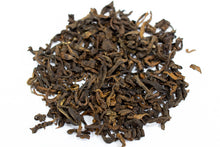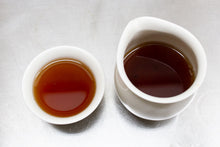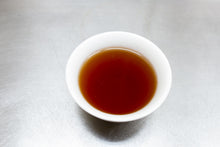We don't just source finished jasmine tea; instead, we bring our own selected raw materials to the jasmine factory to produce custom-made jasmine tea. So far, we have created numerous jasmine teas that are unavailable elsewhere, such as Pu-erh jasmine tea made from raw Pu-erh tea leaves, Jasmine Silver Needle made from ancient tree Yin Zhen (white tea bud), and Jasmine Wild Bud made from wild white buds.
This time, we have processed a tea that we've always wanted to try as jasmine tea. It's ripe Pu-erh tea! You may think that ripe tea and jasmine tea don't go well together, but please give it a try. You'll experience an overwhelming presence and a fresh surprise in how amazingly it complements the jasmine flavor.


Photo of the jasmine scenting process
I was laughed at by the staff and artisans at the jasmine factory.
When I first mentioned that I wanted to process ripe Pu-erh tea into jasmine tea, both our company staff and the artisans at the jasmine factory were skeptical, thinking that ripe tea and jasmine wouldn't go well together. However, ripe Pu-erh tea surprisingly has good compatibility with flowers. In Hong Kong, there is a popular tea called "Kok-pou" which blends ripe Pu-erh tea with chrysanthemum flowers.
Furthermore, in recent years, there has been a trend of stuffing ripe Pu-erh tea inside hollowed-out mandarin oranges and drying them, which has gained popularity.
Ripe tea surprisingly goes well with various types of tea, and did you know that blending ripe tea with black tea in a 1:1 ratio results in a very delicious tea?
Based on these experiences, I firmly believed that ripe tea would have good compatibility with jasmine, and we proceeded with the scenting process somewhat forcefully. Even the jasmine tea artisan repeatedly asked, "Are you sure we should go ahead with this?" It was the first time in his life that he processed ripe tea into jasmine tea.

We used ripe tea made from naturally-grown tea leaves.
When considering the raw materials for ripe pu-erh jasmine tea, nothing other than naturally-grown tea was considered. Naturally-grown tea has a richness and depth when consumed, making it essential for producing high-quality jasmine tea. The ripe tea we used is the popular "Wu Liang Mountain Ancient Tree Ripe Tea" from HOJO. It is made from tea that is naturally-grown without the use of fertilizers or pesticides, and it has a remarkably long-lasting finishing with a distinctive aroma resembling dried fruits like dried jujube. Additionally, we emphasized using the right ratio of the leaves and buds, aiming for a gentle, smooth, and creamy mouthfeel.
An astonishing tea has been completed!
We created this tea based on the assumption that ripe tea and jasmine aroma would complement each other well, but honestly, I was anxious until I actually tasted the finished tea. However, upon drinking it, I couldn't hide my surprise at the perfect combination of the mellow sweetness of ripe tea and the refreshing aroma of jasmine tea.
This tea is recommended for both those who are not fond of jasmine tea and those who are not fond of ripe tea. Due to the jasmine aroma, the distinctive fermented tea scent of ripe tea is completely absent, replaced by the vibrant fragrance of jasmine. Furthermore, thanks to the rich flavor of ripe tea, it provides a satisfying and fulfilling experience when consumed, making it perfect for enjoying during evenings or alongside desserts. This tea is also very suitable for pairing with Chinese dishes and dim sum too.
Additionally, as ripe pu-erh jasmine tea is based on ripe tea, it has a warming effect on the body. It's not just a slight warmth that you can feel, but rather a remarkable sensation of your body becoming pleasantly warm, making it ideal for chilly days or when you want to feel warm and comfortable.
Perfect Pairing with Desserts! The Charm of Black Jasmine Tea
Black jasmine tea is an tea that pairs exceptionally well with desserts. Generally, jasmine tea has a strong personality and a refreshing taste, primarily based on green tea, which means it doesn't necessarily go well with all desserts.
On the other hand,, ripe pu-erh jasmine tea, with its fermented tea base, exhibits a high compatibility with sweets such as pastries that are traditionally considered difficult to pair with jasmine tea. In addition, it complements a wide variety of desserts, including baked apples, apple pies, tarts, cheesecakes, and sweets made with fruit purees or jams. Its compatibility extends to a remarkably broad range of dessert types.

A New Discovery! Black Jasmine Tea Unleashes a New Dimension of Milk Tea
Furthermore, to our astonishment, black jasmine tea creates an incredibly delicious milk tea that even someone like me, who typically enjoys tea straight, finds themselves irresistibly drawn to. When transformed into milk tea, the floral aroma of jasmine takes on a fruity quality, and alongside the smoothness of the milk tea, a sweet fruit fragrance reminiscent of apple tea emerges. In other words, it's a milk tea experience that transcends into a new dimension.
 Enjoying Black Jasmine Tea: Recommended for Cocktails and Shochu
Enjoying Black Jasmine Tea: Recommended for Cocktails and Shochu
Ripe Pu-erh jasmine tea is not only fascinating as a standalone drink but also an intriguing ingredient for cocktails. One simple and outstanding combination is with shochu, a low-alcohol distilled spirit. Try mixing ripe pu-erh jasmine tea with a mild-flavored shochu such as barley, rice, or black sugar-based varieties. Once you experience it, you'll become addicted. Additionally, you can experiment by substituting shochu with other spirits like tequila, rum, or vodka. And if you're looking for a distinct twist, adding milk to ripe pu-erh jasmine tea infused with shochu creates a one-of-a-kind beverage.
With just 5g of tea, you can easily brew over 1 liter of black jasmine tea, making it an economical choice.
Since ripe pu-erh jasmine tea is based on naturally-grown ripe tea, it is best to steep it in boiling hot water. As it is jasmine tea, the tea rinse (pre-heating) is not required. Therefore, a steeping time of about 1 minute is appropriate, and for the second infusion onward, pour the tea out within a few seconds. With 5g of tea leaves, you can brew more than 1 liter of tea effortlessly.
Concerning the occasional presence of green tea mixed in
We carefully select and sort the tea leaves through hand-sorting, and package them with a focus on quality. However, during the production process of jasmine tea, there may be a small amount of green tea or white tea that unintentionally mixes in. This can happen when traces of our previously processed teas, such as Snow Jasmine or Jasmine Silver Needle, remain in the drying machine and occasionally get mixed in. While we make efforts to remove non-ripe pu-erh tea leaves through hand-sorting, it may not be possible to completely eliminate green tea or white tea buds that has the similar color of ripe tea in dry tealeaf form. If you find green tea leaves mixed in when brewing the tea, please understand that it will not affect the taste or aroma. We kindly ask for your kind understanding in such cases.
Recommended Brewing Method
Water for Brewing
In you are using tap water, it is necessary to use a water filter that consists of activated carbon filter. Otherwise, you wouldn't be able to enjoy the authentic taste of tea. If using a commercial mineral water, it is important to choose the natural mineral water. Never use distilled water or reversed osmosis processed water. These water lack of mineral content and thus the taste of tea is too soft and a little plain. Soft water is better than hard water. Brewing tea with hard water makes taste bitter while soft water makes taste gentle and sweet. The softness of water is written on the mineral water bottle as TDS: total dissolved solid. You need to choose the water that TDS is below 200mg/liter.
Use fresh water which has not been boiled before. Bring the cold water to boil and cool down until required temperature. This is to evaporate some chlorine from the water.
Using a Teapot
Hot water: leaf weight = 1:40 (5g of leaf for 200ml of water)
Temperature: boiling hot water
- Rinse teapot with boiling water so as to warm it up.
- Place tea according to the above ratio.
- Gently pour water onto the leaves. Place the lid and brew for about 1 minute.
- After one minute it is ready to drink. Please make sure completely pour off. If hot water remains inside teapot, it will damage tea leaf while tea is waiting for subsequent brewing. Hence it is necessary to use a pitcher so that you do not have to keep tea inside teapot.
- Please remove the lid while you are waiting for subsequent brewing. Tea leaf will be over steamed and get oxidized if the lid is not removed.
- For 2nd brewing, brewing time is about 10 seconds and third brewing onward, please add 10 seconds for each subsequent brewing.






